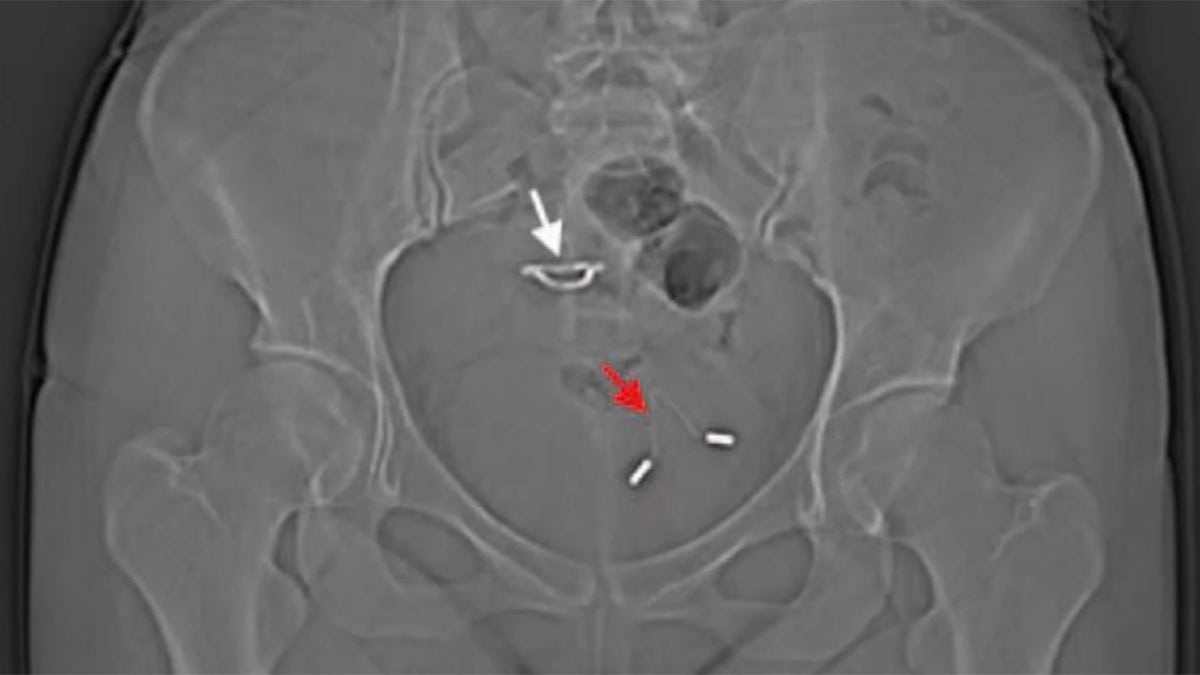
The red arrow points to the IUD in the bladder, while the white arrow points to a second IUD inserted in the uterus. (Wei Chai; Wenlei Zhang; Guifeng Jia; Miao Cui; Lifeng Cui/CC BY-SA 4.0)
A woman's IUD that appeared to be "missing" from her uterus turned up in an unusual place: her bladder.
The woman, a 26-year-old in Changchun, China, went to the doctor because of bladder problems, including increased frequency of urination and blood in her urine, along with pain in her abdomen, according to a report of the woman's case. The patient said she'd had these symptoms for the past five years, and previous treatments hadn't helped.
In addition, she'd had an intrauterine device, or IUD, inserted six years ago, her doctors said. But she'd become pregnant while she had the IUD, and gave birth to the baby via cesarean section in 2012. Doctors didn't find any signs of her IUD during the C-section, and they thought the IUD may have become embedded in the wall of her uterus. She had another IUD inserted after her C-section. (An IUD is a type of long-acting, reversible contraception that is inserted into the uterus. Pregnancy with an IUD is rare, but in this woman's case, it occurred because the IUD moved from its proper position in the uterus.)
WOMAN DIAGNOSED WITH 'BROKEN-HEART SYNDROME' AFTER LOSS OF BELOVED PET
After she reported bladder problems, doctors at The First Hospital of Jilin University in Changchun, China, performed an X-ray of her pelvis and saw something surprising: the "missing" IUD. Indeed, the X-ray revealed that the woman had two IUDs in her body: the more recently inserted IUD, which was in her uterus, and the old IUD, which had "migrated" to her bladder.
"As far as we know, the migration of an IUD into the bladder, where it causes chronic urinary symptoms, occurs rarely," the report said.
The devices are generally very safe, and less than 1 percent of women who use the devices get pregnant each year, according to Planned Parenthood. But in rare cases, they can cause serious problems, including "perforation" of the uterus, meaning that the IUD pushes through the uterine wall. This happens in only about 1 in 1,000 women who get an IUD, the researchers said.
"Once an IUD perforates the uterus, it can move freely into many places," including the abdominal cavity or the pelvic cavity (where the bladder is located), the researchers wrote in their report, which was published in the October issue of the journal Medicine.
In the woman's case, the IUD perforated the uterus, and once it was in the pelvic cavity, it perforated the bladder, the researchers said. The bladder perforation healed without treatment but caused chronic urinary symptoms, they said. The woman had a procedure to remove the IUD from her bladder and did not experience any further complications, the report said.
Although rare, movement of an IUD to the bladder has been reported before — a 2016 report of a similar case in Greece noted that there have been at least 40 cases of IUD migration to the bladder reported in the past 10 years.
Perforation of the uterus by an IUD usually happens when the IUD is inserted. In the Changchun woman's case, the uterine contractions she experienced as a result of pregnancy could have helped the IUD perforate the uterus and migrate to another area, the researchers said.
This case report demonstrates that "a missing IUD should be noticed and immediately removed to avoid further complications," the researchers wrote.
Original article on Live Science.







































